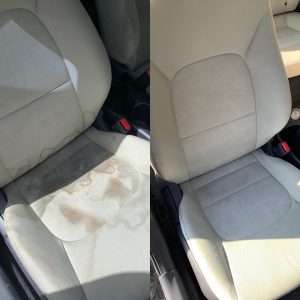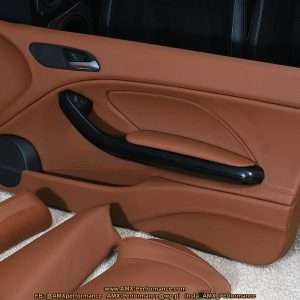Leather car interiors, while luxurious, are susceptible to damage. Sun exposure, spills, and everyday wear and tear can degrade the material. It is important to understand these vulnerabilities to properly protect your investment. Leather is a natural material, and like skin, it requires regular care. Neglecting it can lead to cracking, fading, and discoloration. This section will help you identify the key threats to your car’s leather.
Common Culprits:
- UV Rays: Cause fading and cracking.
- Spills: Can stain and damage the leather’s surface.
- Dirt and Grime: Abrasive particles that wear down the leather.
- Temperature Fluctuations: Extreme heat and cold can dry out the leather.
Regular Cleaning: The Foundation of Protection
Regular cleaning is crucial for maintaining your leather interior. It removes dirt, grime, and spills before they can cause permanent damage. A gentle approach is key to avoid stripping the leather’s natural oils. Use a pH-balanced leather cleaner and a soft microfiber cloth. Avoid harsh chemicals or abrasive cleaners. They can damage the leather’s finish and cause discoloration. A clean interior is a happy interior.
Cleaning Steps:
- Vacuum the interior to remove loose dirt and debris.
- Apply a small amount of leather cleaner to a microfiber cloth.
- Gently wipe down the leather surfaces.
- Use a clean, damp cloth to remove any cleaner residue.
- Dry the leather with a clean, dry microfiber cloth.
Conditioning: Keeping Leather Supple and Protected
Conditioning is essential for replenishing the leather’s natural oils. It prevents cracking and keeps the leather supple and soft. Choose a high-quality leather conditioner that is specifically designed for automotive use. Apply the conditioner sparingly and evenly. Allow it to soak into the leather for several minutes before wiping off any excess. Regular conditioning will keep your leather looking and feeling its best. It’s like giving your leather a spa treatment.
FAQ: Protecting Your Leather Interior
How often should I clean my leather seats?
Ideally, you should clean your leather seats every 1-2 months. This prevents dirt and grime from building up and causing damage. However, if you frequently spill things or have pets in your car, you may need to clean them more often. A quick wipe-down after a spill is always a good idea.
What type of cleaner should I use?
Always use a pH-balanced leather cleaner specifically designed for automotive use. Avoid harsh chemicals, detergents, or abrasive cleaners. These can strip the leather’s natural oils and cause damage. Read the label carefully before applying any cleaner to your leather.
Can I use baby wipes to clean leather seats?
While baby wipes may seem convenient, they are not ideal for cleaning leather seats. They can contain chemicals that can damage the leather over time. It’s best to stick to a dedicated leather cleaner.
How do I protect my leather from sun damage?
Park in the shade whenever possible. Use a sunshade when parking in direct sunlight. You can also apply a leather protectant that contains UV inhibitors. These products help to block harmful UV rays and prevent fading and cracking.
Addressing Stains and Spills Promptly
Act fast when spills occur. The longer a stain sits, the harder it is to remove. Blot the spill immediately with a clean, dry cloth. Avoid rubbing, as this can spread the stain. For stubborn stains, use a leather stain remover specifically designed for the type of stain. Always test the cleaner in an inconspicuous area first to ensure it doesn’t damage the leather. Quick action is key to preventing permanent damage. Don’t let spills linger!
Specific Stain Solutions:
- Ink: Try rubbing alcohol on a cotton swab, blotting gently.
- Grease: Sprinkle cornstarch on the stain to absorb the grease, then vacuum.
- Water-based stains: Blot with a clean, damp cloth.
Protecting Against Wear and Tear
Even with regular cleaning and conditioning, leather can still show signs of wear and tear. Consider using seat covers to protect high-wear areas. Be mindful of sharp objects that could scratch or tear the leather. Avoid wearing clothing with metal embellishments that could rub against the seats. Prevention is always better than cure. Take steps to minimize wear and tear from the start.
Preventative Measures:
- Use seat covers, especially for high-traffic areas.
- Avoid placing sharp objects on the seats.
- Be careful when getting in and out of the car.
Choosing the Right Leather Care Products
Not all leather care products are created equal. Research and choose products that are specifically designed for automotive leather. Read reviews and look for products that are recommended by leather experts. Avoid products that contain harsh chemicals or solvents. The right products will protect and enhance your leather, while the wrong ones can cause damage. Invest in quality for long-term benefits.
Key Considerations:
- pH-balanced: Ensures the product won’t damage the leather’s natural oils.
- UV protection: Helps to prevent fading and cracking.
- Non-greasy formula: Prevents the leather from feeling sticky or oily.
Professional Leather Repair and Restoration
For significant damage, such as cracks, tears, or severe discoloration, consider professional leather repair and restoration. A professional can repair the damage and restore the leather to its original condition. This is often a more cost-effective option than replacing the entire leather interior. Don’t attempt to repair significant damage yourself, as you could make the problem worse. Leave it to the experts.
When to Seek Professional Help:
- Large cracks or tears
- Severe discoloration
- Stubborn stains that you can’t remove




